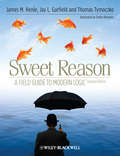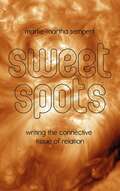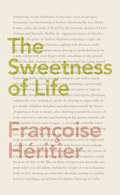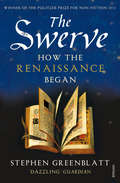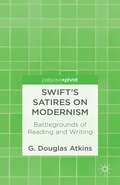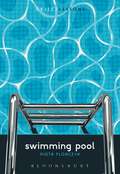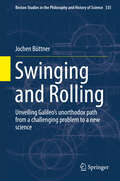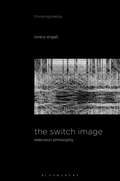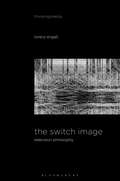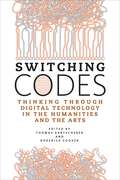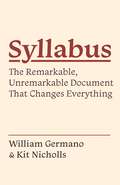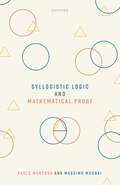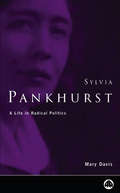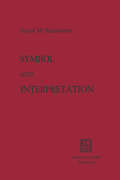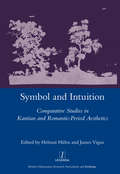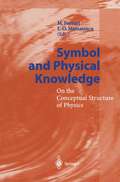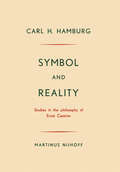- Table View
- List View
Sweet Reason: A Field Guide to Modern Logic
by James M. Henle Jay L. Garfield Thomas TymoczkoSweet Reason: A Field Guide to Modern Logic, 2nd Edition offers an innovative, friendly, and effective introduction to logic. It integrates formal first order, modal, and non-classical logic with natural language reasoning, analytical writing, critical thinking, set theory, and the philosophy of logic and mathematics. An innovative introduction to the field of logic designed to entertain as it informs Integrates formal first order, modal, and non-classical logic with natural language reasoning, analytical writing, critical thinking, set theory, and the philosophy of logic and mathematics Addresses contemporary applications of logic in fields such as computer science and linguistics A web-site (www.wiley.com/go/henle) linked to the text features numerous supplemental exercises and examples, enlightening puzzles and cartoons, and insightful essays
Sweet Spots: Writing the Connective Tissue of Relation
by Mattie-Martha SempertSweet Spots thinks transversally across language and body, and between text and tissue. This assemblage of essays collectively proposes that words—that is, language that lands as written text—are more-than-human material. And, these materials, composed of forces and flows and tendencies, are capable of generating text-flesh that grows into a thinking in the making. The practice of acupuncture—and its relational thinking—often makes its presence felt to twirl the text-tissue of the bodying essays. Ficto-critical thinking is threaded throughout to activate concepts from process philosophy and use the work of other thinkers (William James, Félix Guattari and Gilles Deleuze, Baruch Spinoza, and Virginia Woolf, to name a few) to forge imaginative connections. Entangled in the text-tissue are an assortment of entities, such as bickering body parts, quivering jellyfish, heart pacemaker cells, a narwhal tooth, Taoist parables, always with ubiquitous, stretchy connective tissue — from gooey interstitial fluid to thick planes of fascia — ever present to ensure that the essaying bodies become, what Alfred North Whitehead calls the one-which-includes-the-many-includes-the-one. The essaying bodies orient towards the sweetest sweet spot which is found, not in the center, but slightly askew, felt in the reverbing more-than that carries their potential. Crucially, this produces a shift in perspective away from self-enclosed bodies and experts toward a care for the connective tissue of relation.
The Sweetness of Life
by Françoise Héritier"There is a form of lightness and grace in the simple fact of existence, regardless of occupation, of strong feelings, or of political commitments of any sort - and that is the only thing I have wanted to write about. About that little extra thing that is granted to all of us, a lust for life." So begins Francoise Heritier, in her exploration of the things in life worth living for, the moments and events that give life flavour. An eminent anthropologist, now in her eighties, she draws on her own memories and the wisdom gained in a lifetime of exploration, to show how life is richer and more interesting than we often remember.
The Swerve: How the Renaissance Began
by Stephen GreenblattA riveting, exemplary tale of the great cultural "swerve" known as the Renaissance.WINNER OF THE PULITZER PRIZE FOR NON-FICTION 2012Almost six hundred years ago, a short, genial man took a very old manuscript off a library shelf. With excitement, he saw what he had discovered and ordered it copied. The book was a miraculously surviving copy of an ancient Roman philosophical epic, On the Nature of Things by Lucretius and it changed the course of history.He found a beautiful poem of the most dangerous ideas – that the universe functioned without the aid of gods, that religious fear was damaging to human life, and that matter was made up of very small particles in eternal motion. These ideas fuelled the Renaissance, inspiring Botticelli, shaping the thoughts of Montaigne, Darwin, and Einstein.An innovative work of history by one of the world’s most celebrated scholars and a thrilling story of discovery, The Swerve details how one manuscript, plucked from a thousand years of neglect, made possible the world as we know it.‘Superbly readable... An exciting story, and Greenblatt tells it with his customary clarity and verve’ Robert Douglas-Fairhurst, Daily Telegraph
Swift’s Satires on Modernism: Battlegrounds Of Reading And Writing
by G. AtkinsMore than three centuries later, Jonathan Swift's writing remains striking and relevant. In this engaging study, Atkins brings forty-plus years of critical experience to bear on some of the greatest satires ever written, revealing new contexts for understanding post-Reformation reading practices and the development of the modern personal essay.
Swimming Pool (Object Lessons)
by Dr. Piotr FlorczykObject Lessons is a series of short, beautifully designed books about the hidden lives of ordinary things.As a former world-ranked swimmer whose journey toward naturalization and U.S. citizenship began with a swimming fellowship, Piotr Florczyk reflects on his own adventures in swimming pools while taking a closer look at artists, architects, writers, and others who have helped to cement the swimming pool's prominent and iconic role in our society and culture.Swimming Pool explores the pool as a place where humans seek to attain the unique union between mind and body.Object Lessons is published in partnership with an essay series in The Atlantic.
Swimming Pool (Object Lessons)
by Dr. Piotr FlorczykObject Lessons is a series of short, beautifully designed books about the hidden lives of ordinary things.As a former world-ranked swimmer whose journey toward naturalization and U.S. citizenship began with a swimming fellowship, Piotr Florczyk reflects on his own adventures in swimming pools while taking a closer look at artists, architects, writers, and others who have helped to cement the swimming pool's prominent and iconic role in our society and culture.Swimming Pool explores the pool as a place where humans seek to attain the unique union between mind and body.Object Lessons is published in partnership with an essay series in The Atlantic.
Swinging and Rolling: Unveiling Galileo's unorthodox path from a challenging problem to a new science (Boston Studies in the Philosophy and History of Science #335)
by Jochen BüttnerThis volume explores the reorganisation of knowledge taking place in the course of Galileo's research process extending over a period of more than thirty years, pursued within a network of exchanges with his contemporaries, and documented by a vast collection of research notes. It has revealed the challenging objects that motivated and shaped Galileo's thinking and closely followed the knowledge reorganization engendered by theses challenges. It has thus turned out, for example, that the problem of reducing the properties of pendulum motion to the laws governing naturally accelerated motion on inclined planes was the mainspring for the formation of Galileo's comprehensive theory of naturally accelerated motion.
The Switch Image: Television Philosophy (Thinking Media)
by Lorenz EngellTelevision is the most powerful system of images in the late 20th and early 21st centuries. Nonetheless, TV has attained only little philosophical attention so far, especially compared to other (visual) media such as film. This book looks at TV as what happens on the screen and beyond it; which is mainly the operation of switching images. It therefore proposes a new definition of TV as the first picture that can be switched on, off, and over, which stresses that TV is more tactile than visual. Through the operation of switching, TV figures the world from within and as the course of its figuration. This is grasped here by the term of “ontography”, the human response to the natural environment. Through the ongoing interlacing and bridging of “TV 1.0” (the image is being switched) and “TV 2.0” (the image is a switch), TV exponentially increases the production and circulation of images. It transforms the world and itself from an analogue state to a digital one and from central perspectivism to pluri-perspective. In terms of time, through switching and the switch, it develops and reworks new temporal orderings, such as instantaneity, synchronicity, flow, and seriality. TV makes its own history. In space, it creates a mediasphere as its habitat and hence new forms of being-in-the-world, of proximity and distance, and scale. Anthropologically, it works on what a subject and an object is, on what makes the human being, and ontographically, how it is possible that there is something at all instead of nothing: through switch-images.
The Switch Image: Television Philosophy (Thinking Media)
by Lorenz EngellTelevision is the most powerful system of images in the late 20th and early 21st centuries. Nonetheless, TV has attained only little philosophical attention so far, especially compared to other (visual) media such as film. This book looks at TV as what happens on the screen and beyond it; which is mainly the operation of switching images. It therefore proposes a new definition of TV as the first picture that can be switched on, off, and over, which stresses that TV is more tactile than visual. Through the operation of switching, TV figures the world from within and as the course of its figuration. This is grasped here by the term of “ontography”, the human response to the natural environment. Through the ongoing interlacing and bridging of “TV 1.0” (the image is being switched) and “TV 2.0” (the image is a switch), TV exponentially increases the production and circulation of images. It transforms the world and itself from an analogue state to a digital one and from central perspectivism to pluri-perspective. In terms of time, through switching and the switch, it develops and reworks new temporal orderings, such as instantaneity, synchronicity, flow, and seriality. TV makes its own history. In space, it creates a mediasphere as its habitat and hence new forms of being-in-the-world, of proximity and distance, and scale. Anthropologically, it works on what a subject and an object is, on what makes the human being, and ontographically, how it is possible that there is something at all instead of nothing: through switch-images.
Switching Codes: Thinking Through Digital Technology in the Humanities and the Arts
by Thomas Bartscherer Roderick CooverHalf a century into the digital era, the profound impact of information technology on intellectual and cultural life is universally acknowledged but still poorly understood. The sheer complexity of the technology coupled with the rapid pace of change makes it increasingly difficult to establish common ground and to promote thoughtful discussion. Responding to this challenge, Switching Codes brings together leading American and European scholars, scientists, and artists—including Charles Bernstein, Ian Foster, Bruno Latour, Alan Liu, and Richard Powers—to consider how the precipitous growth of digital information and its associated technologies are transforming the ways we think and act. Employing a wide range of forms, including essay, dialogue, short fiction, and game design, this book aims to model and foster discussion between IT specialists, who typically have scant training in the humanities or traditional arts, and scholars and artists, who often understand little about the technologies that are so radically transforming their fields. Switching Codes will be an indispensable volume for anyone seeking to understand the impact of digital technology on contemporary culture, including scientists, educators, policymakers, and artists, alike.
Switching Codes: Thinking Through Digital Technology in the Humanities and the Arts
by Thomas Bartscherer Roderick CooverHalf a century into the digital era, the profound impact of information technology on intellectual and cultural life is universally acknowledged but still poorly understood. The sheer complexity of the technology coupled with the rapid pace of change makes it increasingly difficult to establish common ground and to promote thoughtful discussion. Responding to this challenge, Switching Codes brings together leading American and European scholars, scientists, and artists—including Charles Bernstein, Ian Foster, Bruno Latour, Alan Liu, and Richard Powers—to consider how the precipitous growth of digital information and its associated technologies are transforming the ways we think and act. Employing a wide range of forms, including essay, dialogue, short fiction, and game design, this book aims to model and foster discussion between IT specialists, who typically have scant training in the humanities or traditional arts, and scholars and artists, who often understand little about the technologies that are so radically transforming their fields. Switching Codes will be an indispensable volume for anyone seeking to understand the impact of digital technology on contemporary culture, including scientists, educators, policymakers, and artists, alike.
Switching Codes: Thinking Through Digital Technology in the Humanities and the Arts
by Thomas Bartscherer Roderick CooverHalf a century into the digital era, the profound impact of information technology on intellectual and cultural life is universally acknowledged but still poorly understood. The sheer complexity of the technology coupled with the rapid pace of change makes it increasingly difficult to establish common ground and to promote thoughtful discussion. Responding to this challenge, Switching Codes brings together leading American and European scholars, scientists, and artists—including Charles Bernstein, Ian Foster, Bruno Latour, Alan Liu, and Richard Powers—to consider how the precipitous growth of digital information and its associated technologies are transforming the ways we think and act. Employing a wide range of forms, including essay, dialogue, short fiction, and game design, this book aims to model and foster discussion between IT specialists, who typically have scant training in the humanities or traditional arts, and scholars and artists, who often understand little about the technologies that are so radically transforming their fields. Switching Codes will be an indispensable volume for anyone seeking to understand the impact of digital technology on contemporary culture, including scientists, educators, policymakers, and artists, alike.
Switching Codes: Thinking Through Digital Technology in the Humanities and the Arts
by Thomas Bartscherer and Roderick CooverHalf a century into the digital era, the profound impact of information technology on intellectual and cultural life is universally acknowledged but still poorly understood. The sheer complexity of the technology coupled with the rapid pace of change makes it increasingly difficult to establish common ground and to promote thoughtful discussion. Responding to this challenge, Switching Codes brings together leading American and European scholars, scientists, and artists—including Charles Bernstein, Ian Foster, Bruno Latour, Alan Liu, and Richard Powers—to consider how the precipitous growth of digital information and its associated technologies are transforming the ways we think and act. Employing a wide range of forms, including essay, dialogue, short fiction, and game design, this book aims to model and foster discussion between IT specialists, who typically have scant training in the humanities or traditional arts, and scholars and artists, who often understand little about the technologies that are so radically transforming their fields. Switching Codes will be an indispensable volume for anyone seeking to understand the impact of digital technology on contemporary culture, including scientists, educators, policymakers, and artists, alike.
Switching Codes: Thinking Through Digital Technology in the Humanities and the Arts
by Thomas Bartscherer and Roderick CooverHalf a century into the digital era, the profound impact of information technology on intellectual and cultural life is universally acknowledged but still poorly understood. The sheer complexity of the technology coupled with the rapid pace of change makes it increasingly difficult to establish common ground and to promote thoughtful discussion. Responding to this challenge, Switching Codes brings together leading American and European scholars, scientists, and artists—including Charles Bernstein, Ian Foster, Bruno Latour, Alan Liu, and Richard Powers—to consider how the precipitous growth of digital information and its associated technologies are transforming the ways we think and act. Employing a wide range of forms, including essay, dialogue, short fiction, and game design, this book aims to model and foster discussion between IT specialists, who typically have scant training in the humanities or traditional arts, and scholars and artists, who often understand little about the technologies that are so radically transforming their fields. Switching Codes will be an indispensable volume for anyone seeking to understand the impact of digital technology on contemporary culture, including scientists, educators, policymakers, and artists, alike.
Switching Codes: Thinking Through Digital Technology in the Humanities and the Arts
by Thomas Bartscherer and Roderick CooverHalf a century into the digital era, the profound impact of information technology on intellectual and cultural life is universally acknowledged but still poorly understood. The sheer complexity of the technology coupled with the rapid pace of change makes it increasingly difficult to establish common ground and to promote thoughtful discussion. Responding to this challenge, Switching Codes brings together leading American and European scholars, scientists, and artists—including Charles Bernstein, Ian Foster, Bruno Latour, Alan Liu, and Richard Powers—to consider how the precipitous growth of digital information and its associated technologies are transforming the ways we think and act. Employing a wide range of forms, including essay, dialogue, short fiction, and game design, this book aims to model and foster discussion between IT specialists, who typically have scant training in the humanities or traditional arts, and scholars and artists, who often understand little about the technologies that are so radically transforming their fields. Switching Codes will be an indispensable volume for anyone seeking to understand the impact of digital technology on contemporary culture, including scientists, educators, policymakers, and artists, alike.
Syllabus: The Remarkable, Unremarkable Document That Changes Everything (Skills for Scholars)
by William Germano Kit NichollsHow redesigning your syllabus can transform your teaching, your classroom, and the way your students learnGenerations of teachers have built their classes around the course syllabus, a semester-long contract that spells out what each class meeting will focus on (readings, problem sets, case studies, experiments), and what the student has to turn in by a given date. But what does that way of thinking about the syllabus leave out—about our teaching and, more importantly, about our students’ learning?In Syllabus, William Germano and Kit Nicholls take a fresh look at this essential but almost invisible bureaucratic document and use it as a starting point for rethinking what students—and teachers—do. What if a teacher built a semester’s worth of teaching and learning backward—starting from what students need to learn to do by the end of the term, and only then selecting and arranging the material students need to study?Thinking through the lived moments of classroom engagement—what the authors call “coursetime”—becomes a way of striking a balance between improv and order. With fresh insights and concrete suggestions, Syllabus shifts the focus away from the teacher to the work and growth of students, moving the classroom closer to the genuinely collaborative learning community we all want to create.
Syllogistic Logic and Mathematical Proof
by Prof Paolo Mancosu Prof Massimo MugnaiDoes syllogistic logic have the resources to capture mathematical proof? This volume provides the first unified account of the history of attempts to answer this question, the reasoning behind the different positions taken, and their far-reaching implications. Aristotle had claimed that scientific knowledge, which includes mathematics, is provided by syllogisms of a special sort: 'scientific' ('demonstrative') syllogisms. In ancient Greece and in the Middle Ages, the claim that Euclid's theorems could be recast syllogistically was accepted without further scrutiny. Nevertheless, as early as Galen, the importance of relational reasoning for mathematics had already been recognized. Further critical voices emerged in the Renaissance and the question of whether mathematical proofs could be recast syllogistically attracted more sustained attention over the following three centuries. Supported by more detailed analyses of Euclidean theorems, this led to attempts to extend logical theory to include relational reasoning, and to arguments purporting to reduce relational reasoning to a syllogistic form. Philosophical proposals to the effect that mathematical reasoning is heterogenous with respect to logical proofs were famously defended by Kant, and the implications of the debate about the adequacy of syllogistic logic for mathematics are at the very core of Kant's account of synthetic a priori judgments. While it is now widely accepted that syllogistic logic is not sufficient to account for the logic of mathematical proof, the history and the analysis of this debate, running from Aristotle to de Morgan and beyond, is a fascinating and crucial insight into the relationship between philosophy and mathematics.
Syllogistic Logic and Mathematical Proof
by Prof Paolo Mancosu Prof Massimo MugnaiDoes syllogistic logic have the resources to capture mathematical proof? This volume provides the first unified account of the history of attempts to answer this question, the reasoning behind the different positions taken, and their far-reaching implications. Aristotle had claimed that scientific knowledge, which includes mathematics, is provided by syllogisms of a special sort: 'scientific' ('demonstrative') syllogisms. In ancient Greece and in the Middle Ages, the claim that Euclid's theorems could be recast syllogistically was accepted without further scrutiny. Nevertheless, as early as Galen, the importance of relational reasoning for mathematics had already been recognized. Further critical voices emerged in the Renaissance and the question of whether mathematical proofs could be recast syllogistically attracted more sustained attention over the following three centuries. Supported by more detailed analyses of Euclidean theorems, this led to attempts to extend logical theory to include relational reasoning, and to arguments purporting to reduce relational reasoning to a syllogistic form. Philosophical proposals to the effect that mathematical reasoning is heterogenous with respect to logical proofs were famously defended by Kant, and the implications of the debate about the adequacy of syllogistic logic for mathematics are at the very core of Kant's account of synthetic a priori judgments. While it is now widely accepted that syllogistic logic is not sufficient to account for the logic of mathematical proof, the history and the analysis of this debate, running from Aristotle to de Morgan and beyond, is a fascinating and crucial insight into the relationship between philosophy and mathematics.
Sylvia Pankhurst: A Life in Radical Politics
by Mary DavisSylvia Pankhurst was a tireless activist for a variety of radical causes, including women's suffrage, labour movements and international solidarity campaigns. She made pioneering contributions to gender and class politics, revolutionary communist politics and the struggles against imperialism, racism and fascism. In addition, Pankhurst founded and edited four newspapers, and wrote and published twenty-two books, and numerous pamphlets and articles.*BR**BR*In this biography, Mary Davis provides a much-needed reappraisal of a woman whose contribution to a wide variety of causes is too often marginalised or overlooked, whether as the employer of the first black journalist in Britain - the activist and writer Claude McKay - or as an early campaigner for pan-Africanism. Pankhurst's changing affiliations and commitments - from her early suffragette activities, though her involvement with disenfranchised and impoverished women in London's East End, to her passionate embrace of the Soviet revolution, the cause of communism worldwide and the fight against imperialism and fascism - mirror the history of radical politics in the twentieth century. *BR**BR*Mary Davis's lucid and accessible account of Pankhurst's political life restores a remarkable woman to her rightful place in twentieth-century history.
Symbol and Interpretation
by D.M. RasmussenFor the past four or five years much of my thinking has centered up on the relationship of symbolic forms to philosophic imagination and interpretation. As one whose own philosophic speculations began at. the end of a cultural epoch under methodologies dominated either by neo-Kantianism or schools of logical empiricism the symbol as a prod uct of a cultural imagination has been diminished; it has been neces sary for those who wanted to preserve the symbol to find appropriate philosophical methodologies to do so. In the following chapters we shall attempt to show, through a consideration of a series of recent interpretations of the symbol, as well as through constructive argu ment, that the symbol ought to be considered as a linguistic form in the sense that it constitutes a special language with its own rubrics and properties. There are two special considerations to be taken ac count of in this argument; first, the definition of the symbol, and sec ond, the interpretation of the symbol. Although we shall refrain from defining the symbol explicitly at this point let it suffice to state that our definition of the symbol is more aesthetic than logical (in the technical sense of formal logic ), more cultural than individual, more imaginative than scientific. The symbol in our view is somewhere at the center of culture, the well-spring which testifies to the human imagination in its poetic, psychic, religious, social and political forms.
Symbol and Intuition: Comparative Studies in Kantian and Romantic-period Aesthetics
by Helmut Huehn"That a symbolic object or work of art participates in what it signifies, as a part within a whole, was a controversial claim discussed with particular intensity in the wake of Immanuel Kant's Critique of Judgment. It informed the aesthetic theories of a constellation of writers in Jena and Weimar around 1800, including Moritz, Goethe, Schelling and Hegel. Yet the twin concepts of symbol and intuition were not only tools of literary and mythological criticism: they were integral even to questions of epistemology and methodology in the fields of theology, metaphysics, history and natural philosophy. The international contributors to this volume further explore how both the explanatory potential and peculiar dissatisfactions of the symbol entered the Anglo-American discourse, focusing on Coleridge, Crabb Robinson and Emerson. Contemporary debates about the claims of symbolic as opposed to allegorical art are kept in view throughout."
Symbol and Intuition: Comparative Studies in Kantian and Romantic-period Aesthetics
by Helmut Huehn"That a symbolic object or work of art participates in what it signifies, as a part within a whole, was a controversial claim discussed with particular intensity in the wake of Immanuel Kant's Critique of Judgment. It informed the aesthetic theories of a constellation of writers in Jena and Weimar around 1800, including Moritz, Goethe, Schelling and Hegel. Yet the twin concepts of symbol and intuition were not only tools of literary and mythological criticism: they were integral even to questions of epistemology and methodology in the fields of theology, metaphysics, history and natural philosophy. The international contributors to this volume further explore how both the explanatory potential and peculiar dissatisfactions of the symbol entered the Anglo-American discourse, focusing on Coleridge, Crabb Robinson and Emerson. Contemporary debates about the claims of symbolic as opposed to allegorical art are kept in view throughout."
Symbol and Physical Knowledge: On the Conceptual Structure of Physics
by M. Ferrari I. O. StamatescuIntroduces the problem of the symbolic structure of physics, surveys the modern history of symbols, proceeds to an epistemological discussion of the role of symbols in our knowledge of nature, and addresses key issues related to the methodology of physics and the character of its symbolic structures.
Symbol and Reality: Studies in the philosophy of Ernst Cassirer
by Carl H. HamburgSince prefaces, for the most part, are written after a book is done, yet face the reader before he gets to it, it is perhaps not surprising that we usually find ourselves addressed by a more chastened and qualifying author than we eventually encounter in the ensuing pages. It is, after all, not only some readers, but the writer of a book himself who reads what he has done and failed to do. If the above is the rule, I am no exception to it. The discerning reader need not be told that the following studies differ, not only in the approaches they make to their unifying subject-matter, but also in their precision and thus adequacy of presentation. In addition to the usual reasons for this rather common shortcoming, there is an another one in the case of the present book. In spite of its comparative brevity, the time-span between its inception and termination covers some twenty years. As a result, some (historical and epistemological) sections reflect my preoccupation with CASSI RER'S eady works during student days in Germany and France. When, some ten years later, CASSIRER in a letter expressed "great joy" and anticipation for a more closely supervised con tinuation of my efforts (which, because of his untimely death, never came to pass), he gave me all the encouragement needed to go to work on a critical exposition of his "symbolic form" con cept.
